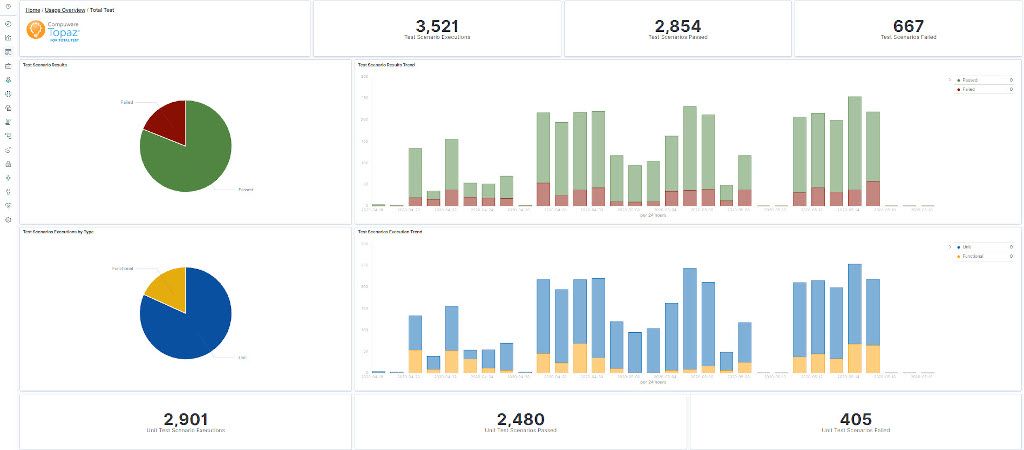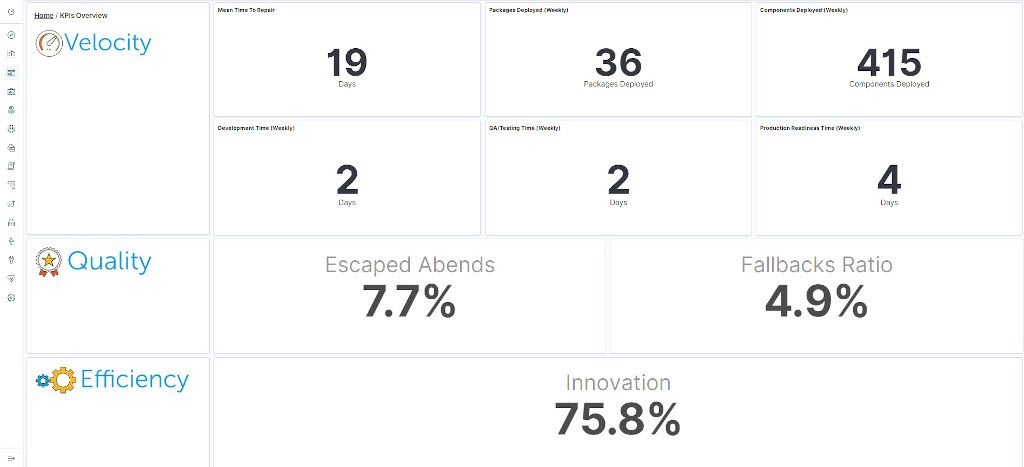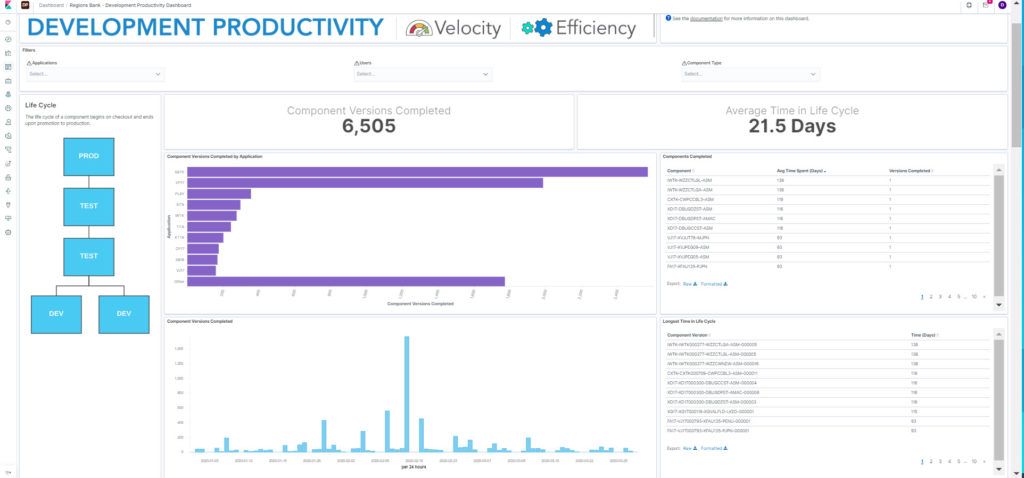Overview: High-performing organizations know that it’s possible to achieve Agile and DevOps on the mainframe. Continuous improvement of software delivery quality, velocity and efficiency relies on the gathering and analysis of meaningful data. Compuware’s zAdviser provides meaningful data and insight to help organizations set goals and measure KPIs so those goals can be achieved.
“High performance” in mainframe software delivery velocity, quality and efficiency has changed radically in the last five years. As the mainframe becomes more strategically relevant, IT departments are asking “How do we know what good looks like?” and “How can we continuously improve our software development and delivery processes?”
Mainframe applications are the systems of record that support the largest companies in the world. Figuring out how to continuously improve mainframe development team performance provides a massive competitive advantage, as reliance on the platform grows and next-gen developers fill critical roles of retiring experts.
Based upon our own experience, as well as working alongside mainframe customers all over the world, we have noticed the emergence of several patterns of “high performance” on the platform.
High performers are obsessed with:
1. Developing customer-obsessed Product Management talent that’s effective in discovering and realizing experiences that are valuable to customers; nailing the jobs customers are trying to get done; and meeting those imperatives with solutions that are economically and technically feasible.
2. Prioritizing, balancing and managing a backlog of net new features, maintenance and defect resolution, while reducing tech debt.
3. Quickly turning ideas that matter into high-quality deliverables that customers care about by building and continuously improving a software delivery platform.
Activities of High-Performing Development Teams
We’ve also observed that high performers do the following key things in the areas of proven practices, automation, integration, and measurement.
• In the case of practices: High performers are practicing Agile development on both new offerings and classic offerings. They work in scrum teams and typically practice two-week sprints, with customer engagement on sprint reviews.
• In the case of automation: High performers have constructed a CI/CD pipeline to do a full build, test and deploy of all software every day. This provides both fast feedback on the previous day’s work and a progressively better quality signal to increase the confidence in reported defects. The collateral benefit of this daily cycle is that they practice doing a full SDLC every day, which prevents surprises and unplanned work, but is also a means to provide continuous delivery/innovation to customers.
• In the case of integration: High performers have created a developer-preferred, state-of-the-art DevOps toolchain that increases the time spent on writing code that customers care about.
• In the case of measurement: high performers assess, on an ongoing basis, customer satisfaction (which is the output work), employee engagement by scrum team and flow metrics as means to identify opportunities to continuously improve. There is always a bottleneck. There is always time wasted. There are always new practices to experiment with, assess the results of, and adapt when there are opportunities for improvement. It’s about moving beyond managing and into coaching.
How Do You Know if You Are Improving?
As mentioned above, measurement is essential. As the adage goes, if you can’t measure it, you can’t improve it. Numerous high-performing mainframe organizations rely on Compuware zAdviser, a free service that provides the ability to measure quality, velocity, and efficiency across the development lifecycle. By capturing a broad range of metrics from development, source code management and IT service management tools, zAdviser supplies a series of Key Performance Indicators (KPIs) and other important metrics—and provides a visualization of those metrics in dashboards that are made ready for customer consumption.
zAdviser incorporates machine learning to identify patterns of good development habits and passes those key patterns onto customers to affect development performance. With zAdviser you can easily measure your developer experience to determine if you are on path to continuous improvement, and if you need to pivot, zAdviser gives you the data to do so smartly. High performance is no accident—it’s practiced and refined daily.
What Does Measurement Look Like?
zAdviser product usage dashboards can show how a development organization (or team) is doing at any given time, as well as indicate improvement over a period. Usage dashboards reveal important information about things like how good we are at testing, how we’re dealing with abends, and how well our developers are adopting the tools put in place for them.

LEAD Technologies Inc. V1.01
Complementing the usage dashboards are the KPI dashboards. The zAdviser KPI dashboards allow the user to monitor and measure a series of critical measurements that our customers and the industry have told us are most important to measure to facilitate development improvement. These KPIs include, but are not limited to, metrics such as mean time to repair bugs, velocity and numbers of elements deployed, abends escaping into production and time spent on innovation versus maintenance. By measuring these KPIs, high-performing organizations make data-driven decisions on how to improve, taking the guesswork out of making important decisions, like how to deploy critical development resources.

LEAD Technologies Inc. V1.01
Measuring Development Productivity
Finally, zAdviser can provide critical metrics around the development lifecycle to help high-performing customers create great software, faster. The zAdviser development productivity dashboards provide insights into the things that are slowing development teams down, like bottlenecks. The dashboards provide intelligence on things like how much rework is being done, which work items were slow to develop, and how much time was spent on work that did not get delivered.
Metrics such as these allow the customer to measure the value their development teams are producing in each phase of development, so they can stop guessing and start making evidence-based judgements that improve throughput, speed time to market and, ultimately, exceed their customers’ expectations.

Compuware’s Success Story
For Compuware, the result of being obsessed with high performance in practices, automation, integration and measurement has allowed us to go from a dearth of new products in 15 years to an unprecedented 22 consecutive quarters of net new capabilities, advancements to classic offerings, integrations with preferred DevOps tools and enhancements to the customer experience.
We have sustained a world-class net promoter score for over three years. Our employee engagement, as measured through a broadly used Gallup Survey, is twice the national average and best in class for software companies. We’ve gone from a company that was in a long state of revenue decline to three consecutive years of both revenue and profitability growth. What’s even more extraordinary is that the headcount within product management and engineering has stayed the same over the last five years. We’ve had no attrition other than retirement, but the retirements have resulted in over a 1/3 of our staff being recent college graduates that are rapidly taking increasing leadership roles in the company.
Of course, none of these achievements would ever be possible without the support of our customers. Their suggestions, feedback and guidance are integral to our continuing success as company. Their fingerprints are all over our quarterly deliveries of new products, updates to classic offerings and DevOps integrations. In fact, with every data contribution they make to zAdviser, the tool becomes more intelligent, more relevant and thus more powerful for organizations committed to continuously improving relative to other teams in their industry vertical, as well as the mainframe ecosystem as a whole.
High Performance is Within Reach for All Organizations
High performance has not only been redefined on the mainframe over last five years, it’s accelerating thanks to mainframe unicorns that understand the value of measurement and continuous improvement. The highest performers treat their developers like highly trained athletes and coach them rather than traditionally managing them. They become laser-focused on the customer experience, integrate with best of breed DevOps tools, and make data-driven decisions by continuously measuring, refining, and improving. Mainframe Agile is real and matters. Mainframe DevOps is real and matters. It’s no longer a dream. It’s a choice.
This post originally appeared on LinkedIn.
These postings are my own and do not necessarily represent BMC's position, strategies, or opinion.
See an error or have a suggestion? Please let us know by emailing blogs@bmc.com.






